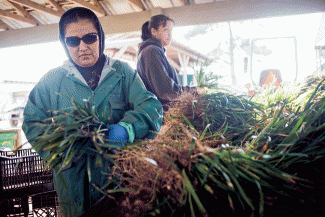The impossible-to-eradicate, imported red fire ant is going to expand farther and crop up in higher concentrations in North Carolina.
This is primarily due to the fact that one type of social colony of these wildly unpopular insects, known for their painful sting and costly impact to the state’s nursery industry, is killing off another, according to Charles Apperson, a professor of entomology at N.C. State University’s Department of Entomology.
Supporter Spotlight
There are two types of fire ant social colonies – monogyne, single-queen colonies, and polygyne, multiple-queen colonies. It’s the polygyne colonies that have the upper hand, destroying single-queen colonies one mound at a time.

“It’s just an evolution of fire ant populations over time,” Apperson said. “They’re going to become more widespread and more problematic because you have more ants per acre than you do the single-queen colony.”
Single-queen colonies are territorial so they distance their mounds from one another. Multiple-queen colonies, on the other hand, work together to build a series of smaller mounds, each with their own queen.
Single-queen colonies will build about 25 mounds an acre. Multiple-queen colonies, which exchange food and workers, build smaller, interconnected mounds. They can build more than 100 mounds an acre, Apperson said.
“With a multiple-queen colony if you kill the queen in a mound they can readily replace that queen so they’re much more difficult to control,” he said.
Supporter Spotlight
The combination of wet and mild temperatures has not helped either.
During warm periods, ants take the opportunity to rebuild their mounds washed out by rain, which is why, if you live in one of the counties infested with the ants, you may have noticed mounds popping up along roadways in recent weeks.
Spreading Nuisance

Native to southern Brazil, red fire ants were first found in Alabama in 1918. It’s thought that the first ones hitched a ride on a ship.
It didn’t take long for their progeny to spread. Fire ants have high reproductive rates and can travel long distances as they mate while flying in the air.
The ants now inhabit 11 Southern states from North Carolina to Texas as well as areas of New Mexico and California, infiltrating more than 367 million acres of U.S. soil.
In North Carolina, the ants were first detected in Brunswick County in 1957 and they have steadily expanded up the entire N.C. coast and can be found as far west as Cherokee County in the state’s mountains. Today, imported red fire ants infest 71 of North Carolina’s 100 counties.
In an effort to try and keep the ants from spreading to other parts of the country, the federal government has quarantined infested areas. At least three quarters of the state is under the quarantine zone. Growers who produce nursery stock such as sod, potted plants and trees within the quarantined areas must meet federal compliance standards in order to ship outside the zone.
The N.C. Department of Agriculture & Consumer Services works closely with the nursery industry to ensure the guidelines are met, said Phil Wilson, plant pest administrator and state plant regulatory official. “Our goal is to mitigate and stop the fire ants from going outside of the quarantined area,” he said.

North Carolina has two levels of nurseries. Registered nurseries sell their stock within the local area and therefore would not have to be under compliance. Certified nurseries, which are larger than one acre, have to be in compliance in order to ship outside of the quarantine zone. There are anywhere from 600 to 700 certified nurseries in North Carolina, Wilson said.
Nurseries that ship outside of the quarantine area are required to incorporate methods such as adding insecticide to potting soil that kills off fire ants.
Most of the nurseries that ship stock buy commercially produced potting soil with insecticide already included in the mix. This is an added cost to the grower, but just part of doing business for nursery operators who’ve been within the quarantine zone for a while.
“The biggest thing we run into is when somebody becomes newly quarantined,” Wilson said. “They haven’t had to spend that money and that’s an adjustment for them.”
A majority of the plants and other stock grown at Johnson Nursery Corp. in Willard is exported outside the state. The Pender County-based business’s 2016 budget includes about $20,000 for fire ant mitigation on the 100-acre nursery, said Carl Potter, the nursery’s head horticulturist.
“Twice a year, starting in the spring, we put out ant bait across the entire grounds of the nursery and then in the fall we do the same thing,” he said.

Nursery workers also make monthly rounds on the grounds, looking for ant mounds to drench with chemicals to kill fire ants. During the past couple of months nursery employees are combating more mounds than usual, Potter said.
“I don’t know which is worse, the rain or the warm weather,” he said. “Normally this time of year, December and January, we wouldn’t see mounds and we’re actually seeing mounds.”
Employees put granulated Talstar, a brand of insecticide that kills fire ants, in each potted plant. This insecticide costs about 15 cents a pound.
“Every plant we pot up here, that granular is put into it,” Potter said. “We probably do a million pots a year so it adds up.”
As the business, which was founded in 1982, expands, so too do costs associated with controlling fire ants.
As the ants expand, more counties are likely to come under quarantine.
“Unfortunately, they’re going to continue to spread,” Wilson said. “The hope is maybe something like a biological control will come along. There are things people can do to treat them, but they’re going to continue to come back. The only thing that really slows them down is cold weather so I think you’re going to see them spread more into other parts of the country.”
We’ve heard of a lot of ways of dealing with fire ants. Turning their nests into art isn’t one of them however. This video got over 73 million views on You Tube, though some people complained that what the video depicts is barbaric, as if slow poisoning is humane. So, if you have a soft spot for an invasive species that is wiping out native ant populations, you might consider looking at something else.
Local Control
Imported red fire ant expansion is not only going to be tough on the agriculture industry, but to the human population as well.
Fire ants are aggressive insects that bite with their jaws while simultaneously injecting their venom from a sharp stinger near their bellies. Since humans usually come into contact with a mound instead of a single ant, they’re likely to be stung multiple times.
Red ant stings leave itchy, painful pustules. Fire ant stings can be especially dangerous to someone who has an allergic reaction, which can take the form of swelling and, in severe cases, difficulty breathing.
There are several variations of treatment, including creating a paste of baking soda and water to apply to each sting.

Apperson suggests ice. “The best thing to do is immediately put ice on it and alleviate the itching,” he said.
After ice has been applied and removed, follow up by dabbing a topical cortisone ointment onto each sting.
Though they can’t be eliminated, red fire ants can be controlled. That effort falls to individual property owner.
“You just have to control them locally,” Apperson said. “It’s just going to involve a concerted effort on the local and community basis.”
Boiling water is one method that works well in killing off a fire ant colony. Apperson suggests using one gallon of boiling water per six inches of mound diameter.
“If you want immediate control the best thing you can do is drench the mound,” Apperson said.
Property owners can also use bait, such as AMDRO fire ant killer. Sprinkle the bait around a mound, not directly on top of it.
“Usually it’s best to make those treatments in the early morning when the sun is shining on the mound,” he said.
Oh, and those home remedies you may have heard about, like sprinkling grits or coffee grounds around a mound or pouring gasoline over a mound, they do not work, Apperson said.
“They just pick up their young and fragment the colony and gradually they’ll get back together again,” he said. “The ants are here to stay, unfortunately.”







